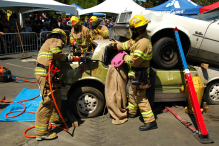Nicole Avila, daughter of George Avila (President/CEO Action Training Systems) has been on the fast track when it comes to accomplishing her goals. Her early graduation comes as no surprise as she has always set her standards above many others her age. Nicole knew she wanted a career in emergency services field since she was sixteen. Her passion was initially sparked while taking athletic medicine and anatomy courses her sophomore year of high school. Her enthusiasm drove her to apply to the running start program at her high school and to graduate at eighteen with her Associate of Arts degree.

Nicole said that the defining event was the summer before her senior year. She applied to attend Camp Blaze. This is a week-long camp held in different parts of the county and is designed to empower young women looking toward a career in the fire service. “It was really because of Camp Blaze that I developed a strong passion for wanting to be a firefighter. It was the first time I got to pull a hose line into a burning building, and I loved it,” said Nicole. “All the women who run that program are amazing, they give young women the opportunity to see that they have the strength and ability to do something like firefighting, and to be strong and confident leaders in whatever field we end up in.”

After attending Camp Blaze Nicole began applying to colleges that offered a fire science degree. Ultimately she decided that the University of New Haven (UNH) in Connecticut would be the best fit. She moved across the country and began her life as a college student in the fall of 2012. Having her prerequisites out of the way allowed her to start college as a junior and dive right into her fire science courses. She excelled in all her classes and stood out among her peers. “Nicole is one of those unique students that come through the university who possess a passion for public service, academic ability, and the confidence to make a real difference in emergency services,” said Peter J. Struble, Paramedicine Coordinator and one of Nicole’s favorite professors at UNH. “The fun part of teaching is when you can see tomorrow’s leaders begin to stand apart from the crowd. Nicole is one of those leaders and will be force for positive change in fire and emergency services.”
While enrolled in school, Nicole also looked for opportunities to be involved in the fire service community. She knew volunteering for a local department would give her hands on experience to the material she was studying. She applied to Allentown Volunteer Fire Association. In addition to a full load of fire courses at college, as a volunteer at Allentown she completed her initial Firefighter 1 & 2 courses at night and participated in hands on drills during weekends. “To many, this schedule might seem like a heavy load but Nicole just has a way of getting things done and never complaining,” said Elise Avila Andreasen, sister and marketing manager at Action Training Systems. “You could tell she was happy pursuing her passion. Her unwavering determination is an inspiration. We couldn’t be more proud of her success so far.”

While taking her Firefighter 1 & 2 training with Allentown Vol. Fire Dept., Nicole was excited to see that the department was using training programs produced by her family’s company. She had recognized early on that her family’s business was influential in her career choice but it wasn’t until that moment that she fully realized the impact and incredible resources she has had available to her. “Throughout much of her life, Nicole has been inspired by many close family friends that have had very successful careers in the fire service,” said George Avila. “Some of these, to name a few, B.C. Dennis Corbett, Puyallup Fire & Rescue, retired; B.C. Bruce Arvisu, Los Angeles County Fire, retired; and B.C. Mark Johnson, San Francisco Fire Department. Nicole possesses many of their exceptional leadership qualities that will ensure her a very successful career in the emergency response community for years to come. Needless to say, I am extremely proud of Nicole!”
Nicole finished her bachelor’s degree in Fire Science Administration and graduated this spring at the age of twenty. A huge accomplishment recognized by everyone who has witnessed her steadfast commitment to her goals. This is only the beginning of what appears to be a very promising future in the Emergency Services field. Most recently she has applied to the San Francisco Fire Department. “I want to work for a large city department because I am attracted to the excitement of a big department. I also feel it is a place where I can gain a lot of experience, and if and when I get the opportunity to move up in the department I’d have a larger platform to speak from to make a difference in the fire service as a whole,” said Nicole. Other future interests include becoming a training officer, Chief, working in disaster/emergency management or even attaining her Masters in Emergency Management.
“Training in fire and emergency services is rapidly changing from a top down structured environmentto one where our newest members have opportunities and an environment in which they can analyzeinformation, understand concepts, and reflect on what they learn to improve performance,” said PeterStruble. “The pressures for this change come from a new generation of highly educated, technologicallysavvy, and open minded fire and emergency personnel.”
All those who know Nicole believe she fits the mold when it comes to ensuring the emergency service training continues to move in the direction Struble has outlined. She is a forward thinking leader and we wish her much success in her journey.





 For instance, your jurisdiction may have a highly developed downtown area, and you may notice that your department has performed several elevator rescues in recent years. This information may motivate you to update your team’s elevator rescue training and review the elevator surveys of the buildings within your jurisdiction.
For instance, your jurisdiction may have a highly developed downtown area, and you may notice that your department has performed several elevator rescues in recent years. This information may motivate you to update your team’s elevator rescue training and review the elevator surveys of the buildings within your jurisdiction.
 Online learning is HOT and for a very good reason. Many departments and organizations around the world are turning to online training/learning as a way to decrease costs and improve the learners performance. Also, unlike a one-time classroom session, the online learning course is available to be accessed anywhere and can be reviewed a number of times to enhance the learners comprehension.
Online learning is HOT and for a very good reason. Many departments and organizations around the world are turning to online training/learning as a way to decrease costs and improve the learners performance. Also, unlike a one-time classroom session, the online learning course is available to be accessed anywhere and can be reviewed a number of times to enhance the learners comprehension.